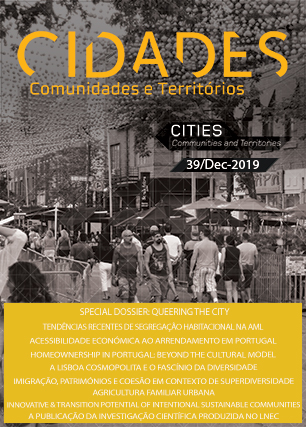Village People: reflexões críticas acerca de um espaço de laser gay-branded em Roma
Palavras-chave:
Village, gay-branded consumption, heteronormativity, Rome, WestResumo
Gay Village is a three-month-long summertime festival, organised in the capital of Italy: Rome. It was created in 2002, after the success of the 2000 World Pride, and has quickly turned into a key event in Rome’s summertime entertainment. Ethnographic work at the Gay Village 2017 edition revealed a significant presence of heteronormed cisgender young men among the festival crowd; their experience of and practices throughout the dancing nights often turned into forms of aggressive spatial appropriation, which easily produced a sense of discomfort and lack of safety among women and queer subjectivities. The case study aims at understanding how this form of heteronormed colonisation has come about, in an effort to revive the intellectual debate on gay-branded spaces of consumption. While scholarly work has thoroughly investigated the progressive ‘straightening’ of mainstream gay-connoted venues, Rome’s Gay Village appears to be an urban artefact that not only does not convincingly challenge spatial heteronormativity, but to a certain extent it also fails to successfully replicate a classic paradigm of ‘urban gay-friendliness through consumption’. And this happens in a metropolitan context that is fully integrated within the common notion of ‘West’. Consequently, Rome’s Gay Village challenges, from within, assumptions on the uniformity of the geopolitical construct of ‘West’ in terms of gender and sexual matters, while also echoing the scholarly problematisation of urban models attempting to conjugate queer liberation with capital accumulation.
Referências
Bell, D., Binnie, J. (2004), “Authenticating Queer Space: Citizenship, Urbanism and Governance”, Urban Studies, 41(9), pp. 1807-1820.
Binnie, J. (1995), “Trading Places: Consumption, Sexuality and the Production of Queer Space”, in D. Bell, G. Valentine (Eds.), Mapping desire: geographies of sexualities, London: Routledge, pp. 182-199.
Cardano, M. (2011), La ricerca qualitativa, Bologna: Il Mulino.
Cattan, N., Vanolo, A. (2014), “Gay and lesbian emotional geographies of clubbing: reflections from Paris and Turin”, Gender, Place and Culture: A Journal of Feminist Geography, 21(9), pp. 1158-1175.
Doan, P. L. (2007), “Queers in the American City: Transgendered perceptions of urban space”, Gender, Place and Culture, 14(1), pp. 57-74.
Duggan, L. (2003), The Twilight of Equality? Neoliberalism, Cultural Politics and the Attack on Democracy, Boston: Beacon Press.
Ende, M. (1979), Die Unendliche Geschichte, Germany: Thienemann Verlag.
Florida, R. (2002), The Rise of the Creative Class: And How It's Transforming Work, Leisure, Community and Everyday Life, New York: Basic Books.
Florida, R. (2005), Cities and the Creative Class, New York: Routledge.
Hemmings, C. (2002), Bisexual spaces: A geography of sexuality and gender, New York, NY: Routledge.
Johnston, L. (2005), Queering Tourism. Paradoxical performances at gay pride parades, New York: Routledge.
Longhurst, R. (2001), Bodies. Exploring fluid boundaries, London and New York: Routledge.
Longhurst, R. (2005), “Situating Bodies”, in L. Nelson, J. Sieger (Eds.), A Companion to Feminist Geography, Oxford: Blackwell, pp. 337-350.
Malbon, B. (1999), Clubbing. Dancing, ecstasy and vitality, London:Routledge.
McNeill, D. (2003), “Rome, global city? Church, state and the Jubilee 2000”, Political Geography, 22, pp. 535-556.
Miller, D. (Ed.). (1998), Material cultures. Why some things matter, London: UCL Press.
Mora Gaspar, V. L. (2016), Al margen de la naturaleza. La persecución de la homosexualidad durante el franquismo. Leyes, terapias y condenas, Madrid: Debate MSV.
Morali, J. (1977), Macho Man. [Recorded by Village People], On Macho Man [vinyl album], New York City, USA: Sigma Sound Studios.
Mudu, P. (2002), “Repressive tolerance: The gay movement and the Vatican in Rome”, GeoJournal, 58, pp. 189-196.
Nast, H.J. (2002), “Prologue: crosscurrents”, Antipodes, 35(5), pp. 844-862.
Nast, H.J. (2002), “Queer racisms, queer patriarchies, International”, Antipodes, 35(5), pp. 874-909.
Podmore, J. A. (2013), “Lesbians as Village ‘Queers’: The Transformations of Montréal’s Lesbian Nightlife in the 1990s”, ACME: An International E-Journal for Critical Geographies, 12(2), pp. 220-249.
Rinaldi, C. (2015), ““Rimani maschio finché non ne arriva uno più maschio di te”. La costruzione delle maschilità omosessuali tra normalizzazione, complicità e consume”, Ragion pratica. Rivista semestrale, 2, pp. 443-462.
Sassen, S. (2013). The Global City: New York, London, Tokyo. Princeton: Princeton University Press.
Sibalis, M. (2004), “Urban Space and Homosexuality: The Example of the Marais, Paris' 'Gay Ghetto'”, Urban Studies, 41(9), pp. 1739-1758.
Skeggs, B. (1999), “Matter out of place: visibility and sexualities in leisure spaces”, Leisure Studies, 18(3), pp. 213-232.
Sothern, M. (2004), “(Un)Queer patriarchies: Or, “What We Think When We Fuck””, Antipodes, 36(2), pp. 183-190.
Taylor, I. & Jamieson, R. (1997), “‘Proper little mesters’: nostalgia and protest masculinity in de-industrialised Sheffield”, in S. Westwood, J. Williams (Eds.), Imagining Cities: Scripts, Signs, Memory, London: Routledge, pp. 152–78.
Valentine, G. (1995), “Out and About: Geographies of Lesbian Landscapes”, International Journal of Urban and Regional Research, 19(1), pp. 96-111.
Weston, K. (1995), Get thee to a big city: sexual imaginary and the great gay migration, GLQ: A Journal of Lesbian and Gay Studies, 2, pp. 253-277.
Downloads
Publicado
Edição
Secção
Licença
CIDADES, Comunidades e Territórios by DINÂMIA'CET-Iscte is licensed under a CC-BY licence.







